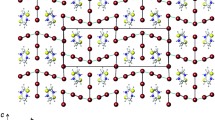Abstract
AMONG the compounds theoretically obtainable by replacing sulphur atoms in the octasulphur ring by imino groups, heptasulphur imide and tetrasulphur tetraimide have long been known. Last year the 1–3, 1–4 and 1–5 isomers of hexasulphur diimide were reported independently by Tavs, Schultze-Steinen and Colchester1, and by one of us2, and we have since confirmed the structures proposed in the latter reference by measurement of dipole moments3. Excluding compounds with adjacent imino groups, none of which is known, there remained to be made only two sulphur imides derived from octasulphur in its normal ‘crown’ conformation, namely, the 1–3–5 and 1–4–6 isomers of pentasulphur triimide. We now report the preparation of two compounds which we think are these.
Similar content being viewed by others
References
Tavs, H., Schultze-Steinen, H. J., and Colchester, J. E., J. Chem. Soc., 2555 (1963).
Heal, H. G., Nature, 199, 371 (1963).
Heal, H. G., and Kane, J. (unpublished results; the isomers A, B and C (ref. 2) had moments 1.74, 1.23 and 2.28 Debye units respectively).
Becke-Goehring, M., Jenne, H., and Fluck, E., Ber., 91, 1947 (1958).
Author information
Authors and Affiliations
Rights and permissions
About this article
Cite this article
HEAL, H., KANE, J. Pentasulphur Triimides : Completion of a Class of Cyclic Sulphur Imides. Nature 203, 971–972 (1964). https://doi.org/10.1038/203971a0
Published:
Issue Date:
DOI: https://doi.org/10.1038/203971a0
- Springer Nature Limited




